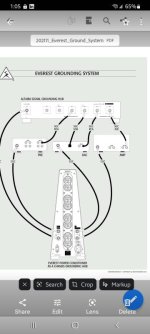johnthomas
Member
Mike, just curious were you able to compare the sound of Everest CGS grounding post to components vs. Altaira CGS to components? I’m assuming the Altaira would be more beneficial.
Mike, just curious were you able to compare the sound of Everest CGS grounding post to components vs. Altaira CGS to components? I’m assuming the Altaira would be more beneficial.
No. We asked this question and Caelin indicated the use of the Altaira would yield superior results due to the individual isolation, etc. We’ve been using Altaira since February and every time we A/B with it in and out of the system, we are shaking our heads. One experiment we want to try is tapping into the ground lug on the Fyne Audio speakers.
More…
“Big differences in filtering and isolation between grounded devices. The Everest has one GP-NR for all ground posts, Altairas have one for each ground post.”
Sent from my iPad using Tapatalk Pro
...We’ve been using Altaira since February and every time we A/B with it in and out of the system, we are shaking our heads...
The A/B referred to was A = Altaira and B = nothing, or B = Everest GP-NR?
But the wiring diagram in the Altaira documentation shows it being grounded to the power distributor.
So in practice you have found that Altaira not connected to Everest sounds better than connected to Everest GP-NR? If so that would seem to fly in the face of the wiring diagram.
So this is true even though the M-10X does have a signal ground post? Interesting.“If they don’t have the IEC ground pin then they cannot be grounded by way of Altaira, at least conventionally. The continuity work sheet has this ground pin question as one of the first. So for now, Luxman is a no.”
Sent from my iPad using Tapatalk Pro
So the short story is: signal grounds do not get connected to Everest. Component signal grounds get connected to Altaira, and Altaira gets connected to Everest.

Hi Mike,
Just watched your awesome interview with Caelin on What's Best Forum. Great job by all parties! Thank you for doing this.
Thank you. Let me know if that’s something you want to discuss further.
Sent from my iPhone using Tapatalk Pro
